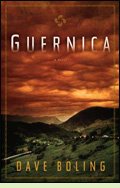|
Guernicaby Dave BolingReviewed by Susan Gillmor Justo Ansotegui is the head of his family and of his family’s rural homestead near Guernica. One of his brothers becomes a fisherman in the village of Lekeitio, a livelihood which for self-respecting Basques is intrinsically connected with the smuggling trade. Another becomes a priest who develops close ties to José Antonio Aguirre, the first president-in-exile of the Basque people. While Fascist rebel Francisco Franco seeks to crush the Basque nation during the Spanish Civil War, the Basques resolve to survive. They know their “language always has been the most important act of separation.” Children understand that the warning “Watch your language” means to avoid speaking Basque among the wider public. With gleeful stealth, the cheerful Ansotegui family revels in tending their astokilos (donkeys), dancing their jotas, and honoring the village amumas (grandmothers). On the fateful day of April 26, 1937, Miren Ansotegui Navarro is in the marketplace of Guernica with her baby daughter and her mother. Her husband Miguel is working outside of town. Justo is working his land. The Germans decide Guernica will be the Luftwaffe’s target that day, its obliteration the goal. The novel has drawn us so far into the lives of Guernica’s people that it's almost impossibly painful to read about the bombing. In the aftermath of destruction, Guernica rises from the ashes. Survivors continue to rebel. The Ansoteguis and Navarros smuggle Jews and stranded RAF pilots out of Nazi Europe as they help restore the broken heart of the Basques. Guernica is a marvel of perfect pacing and agonizing beauty. (2008; 367 pages, including an Author’s Note separating fact from fiction and an Acknowledgement with additional facts and a bibliography) More about Guernica at Powell's Books or Amazon.com
The Wrong Blood by Manuel de Lope (2000 in the original Spanish; first English edition 2010), about a Basque village during the Spanish Civil War. More info The Mule by Juan Eslava Galan (2003 in the original Spanish; first English edition 2008), about a muleteer whose chief objective during the Spanish Civil War is to protect his mule. More info Winter in Madrid by C.J. Sansom (2006), about a British spy in Madrid during the aftermath of the Spanish Civil War. Review or More info at Powell's Books
Guernica and Total War by Ian Patterson (2007), about the bombing of Guernica and the ethical questions raised by aerial warfare. More info Telegram from Guernica: The Extraordinary Life of George Steer, War Correspondent by Nicholas Rankin (2003), a biography of the journalist who exposed the secret involvement of the Nazis in the bombing of Guernica. More info Guernica: The Biography of a Twentieth-Century Icon by Gijs van Hensbergen (2004), the story of Picasso's painting of the bombing of Guernica. More info
The history of Guernica at the town's official website, beginning with prehistoric times Back to 20th Century: World War II Home Front, Europe
|
